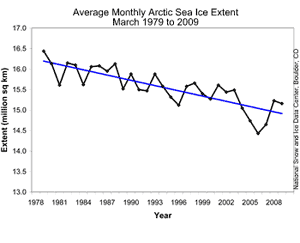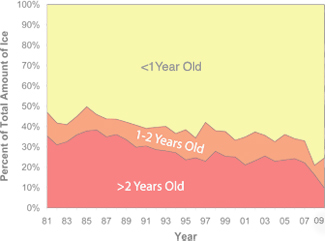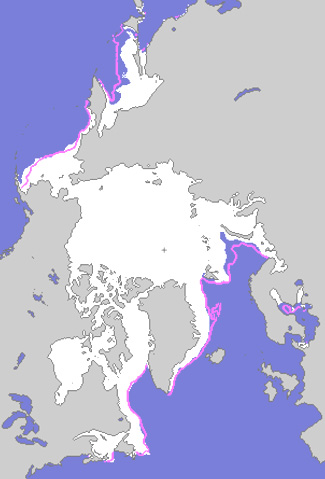| |
 |
| |
Arctic is literally on thin ice
6 April 2009
National Snow and Ice Data Center (NSIDC), Boulder, Colorado
The extent of Arctic sea ice has begun its seasonal decline towards the September minimum. Ice extent through the winter was similar to that of recent years, but lower than the 1979 to 2000 average.
More importantly, the warmer season has begun with a lot of thin first-year ice vulnerable to melt.
Sea ice extent averaged over the month of March 2009 was 15.16 million square kilometers (5.85 million square miles). |
| |
 |
| |
A substantial amount of thinner, first-year sea ice is more vulnerable to summer melting. |
| |
 |
|
| |
This was 730,000 sq.km (282,000 sq.miles) above the record low of 2006, but 590,000 sq.km (228,000 sq.miles) below the 1979 to 2000 average. |
| |
Arctic winter warmer than average
Overall, it was a fairly warm winter in the Arctic. Air temperatures over the Arctic Ocean were an average of 1°C to 2°C (1.8°F to 3.6°F) above normal, with notable regional variations.
The Barents Sea region was over 4°C (7.2°F) warmer than average this winter. This warmth probably stemmed from unusually low sea ice extent in the region throughout much of the winter, which allowed the ocean to pump heat into the atmosphere.
The Bering Sea, in contrast, had a cool winter, with temperatures 1°C to 2°C (1.8°F to 3.6°F) below average. The cooler conditions were consistent with the above-average sea ice extent in the Bering Sea through the winter. |
| |
 |
| |
Below: The extent of sea ice during the past six years has been substantially lower than normal. The linear trend indicates that for the month of March, sea ice is declining by 2.7 percent per decade, an average of 43,000 square kilometres (16,000 sq.miles) each year.
Image: National Snow and Ice Data Center |
| |
 |
| |
Right: The extent of Arctic sea ice in March 2009 was 15.16 million sq.km (5.85 million sq.miles). The magenta line shows the 1979 to 2000 median extent for that month. The black cross indicates the geographic North Pole.
Image: National Snow and Ice Data Center |
| |
 |
| |
 |
|
| |
 |
| |
Top: The median Arctic sea ice age from 1981 to 2000 (left), and the sea ice age at the end of February 2009 (right). First year ice less than one year old is shown in yellow, second year ice which is one to two years old is orange, and ice more than two years old is colored red.
These images show declining sea ice age, which indicates a thinning Arctic sea ice cover more vulnerable to melting in summer. Ice older than two years now accounts for less than 10% of the ice cover.
Images: National Snow and Ice Data Center, courtesy of J. Maslanik and C. Fowler, University of Colorado |
|
| |
 |
| |
Sea ice is thinner than the average .....
As the melt season begins, the Arctic Ocean is covered mostly by first-year ice, which formed this winter, and second-year ice, which formed during the winter of 2007 to 2008.
First-year ice in particular is thinner and more prone to melting than thicker, older ice. This year, ice older than two years accounted for less than 10% of cover at the end of February.
From 1981 through 2000, an average of 30 percent of total ice was older at this time of the year.
While ice older than two years reached record lows, the fraction of second-year sea ice increased from last winter. Some second-year ice will survive the summer melt season to replenish the Arctic's store of older ice, however, in recent years less young ice has made it through the summer.
To restore the amount of older ice to pre-2000 levels, large amounts of this young ice would need to endure the summer for several years in a row. |
|
| |
 |
| |
Conditions may not always favour the survival of second-year and older ice. Each winter, winds and ocean currents move some sea ice out of the Arctic.
This winter, some second-year ice survived the 2008 melt season only to be pushed out of the Arctic by strong winds. Since September 2008, 390,000 sq.km (150,000 sq.miles) of second-year ice and 190,000 sq.km (73,000 sq.miles) of older ice was moved out. |
|
| |
 |
| |
|


